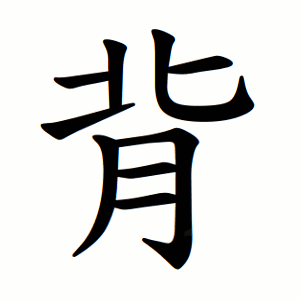背
- back (of the body), to turn one’s back, behind, to carry on the back;
- to recite, to memorize;
Etymology
背 is derived from 北 (buk, “north”).
北 originally depicted two people standing back to back. This gave the meaning “to turn away, to oppose,” before being semantically shifted to “north.”
Once 北 was primarily associated with “north,” a new character 背 was created to preserve the original meaning of “back.”
To clarify the sense of the body part, the flesh radical 月 (variant of 肉, “flesh”) was added to 北.
Thus, 背 is both a compound ideograph and a phono-semantic character, highlighting both the physical body (flesh) and the semantic root in 北 (“back-to-back”).
Usage in Korean
In Korean, 배 (背) retains the meanings “back, to turn one’s back, to carry on the back,” and is very productive in compounds:
배신 (背信) – betrayal (lit. “turning back on trust”)
배반 (背反) – betrayal, treachery
배낭 (背囊) – backpack
배부 (背負) – to carry on the back, to shoulder
등배 (背) – the back (as a noun, in classical/compound usage)
Note: In Korean, 배 (背) can sometimes be confused with the native word 배 (腹, stomach/belly) because of identical pronunciation. For example, 배갑 (背甲, turtle shell, “carapace”) may mistakenly be understood as “belly shell.”
Words that derived from 背
- 中心月 (LPB)
- ⿱ 北 月 (G J K)
- ⿱ 北 ⺼ (H T)
